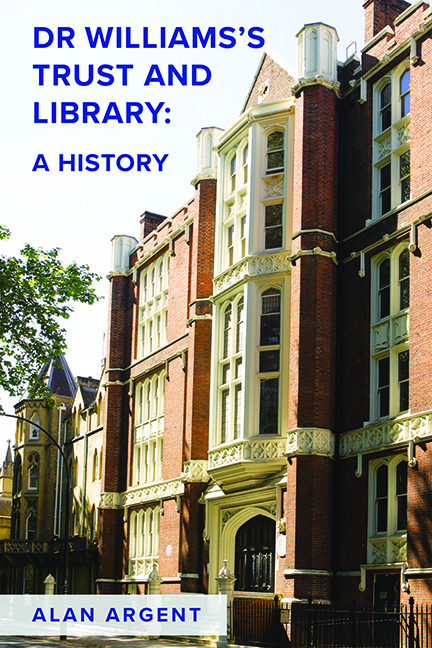Book contents
- Frontmatter
- Dedication
- Contents
- List of Illustrations
- Foreword
- Preface
- Abbreviations
- Notes on Dates, Money, Welsh Place Names and Publications
- Prologue
- 1 Dr Williams and His Will
- 2 Benjamin Sheppard, Receiver 1721–31: Faith, Fitness, and Diligence
- 3 Constructing the Library Building 1725–30: A Proper Plan
- 4 Francis Barkstead, Receiver 1731–47: Piety and Charity
- 5 John Cooper, Receiver 1748–62: Liberty and Liberal Dissent
- 6 Richard Jupp junior, Receiver 1762–95: A Very Respectable Body
- 7 Richard Webb Jupp, Receiver 1795–1850, and David Davison, Receiver 1850–7: Fashionable Sympathies Amid Increasing Light
- 8 Walter D. Jeremy, Receiver 1857–93: The Scrupulous Observer
- 9 Francis H. Jones, Secretary and Librarian 1886–1914: Introducing Order
- 10 Robert Travers Herford, Secretary and Librarian 1914–25: Application and Imagination
- 11 Stephen Kay Jones, Librarian 1925–46, and Joseph Worthington, Secretary 1925–44: A New Age with Old Strains
- 12 Roger Thomas, Secretary 1944–66 and Librarian 1946–66: Trusted Innovator
- 13 Kenneth Twinn, Secretary and Librarian 1966–76: Modest Dependability
- 14 John Creasey, Librarian, and James McClelland, Secretary, 1977–98: Mixed Blessings
- 15 David Wykes, Director 1998–2021: Past, Present, and Future
- 16 Dr Williams’s Trust: An Assessment
- Appendix 1 Trustees in 1723
- Appendix 2 Lists from Short Account (with later additions)
- Bibliography
- Index
3 - Constructing the Library Building 1725–30: A Proper Plan
Published online by Cambridge University Press: 26 May 2022
- Frontmatter
- Dedication
- Contents
- List of Illustrations
- Foreword
- Preface
- Abbreviations
- Notes on Dates, Money, Welsh Place Names and Publications
- Prologue
- 1 Dr Williams and His Will
- 2 Benjamin Sheppard, Receiver 1721–31: Faith, Fitness, and Diligence
- 3 Constructing the Library Building 1725–30: A Proper Plan
- 4 Francis Barkstead, Receiver 1731–47: Piety and Charity
- 5 John Cooper, Receiver 1748–62: Liberty and Liberal Dissent
- 6 Richard Jupp junior, Receiver 1762–95: A Very Respectable Body
- 7 Richard Webb Jupp, Receiver 1795–1850, and David Davison, Receiver 1850–7: Fashionable Sympathies Amid Increasing Light
- 8 Walter D. Jeremy, Receiver 1857–93: The Scrupulous Observer
- 9 Francis H. Jones, Secretary and Librarian 1886–1914: Introducing Order
- 10 Robert Travers Herford, Secretary and Librarian 1914–25: Application and Imagination
- 11 Stephen Kay Jones, Librarian 1925–46, and Joseph Worthington, Secretary 1925–44: A New Age with Old Strains
- 12 Roger Thomas, Secretary 1944–66 and Librarian 1946–66: Trusted Innovator
- 13 Kenneth Twinn, Secretary and Librarian 1966–76: Modest Dependability
- 14 John Creasey, Librarian, and James McClelland, Secretary, 1977–98: Mixed Blessings
- 15 David Wykes, Director 1998–2021: Past, Present, and Future
- 16 Dr Williams’s Trust: An Assessment
- Appendix 1 Trustees in 1723
- Appendix 2 Lists from Short Account (with later additions)
- Bibliography
- Index
Summary
The search for premises for DWL, although determined, was protracted. Having ruled out available City properties, before opting to build, the trustees found that they had been allotted insufficient funds to complete all necessary works. In response, the trustees and their friends proved generous. To understand that generosity fully, £1 in 1730 was equivalent in purchasing power to about £220 in 2020.
DWL's Need for a Site
The trustees authorised John Evans, Zachary Merrell, and Samuel Lessingham in December 1725 to enquire about a particular site for DWL. Evans felt that if the owner knew why it was wanted he might either refuse to sell or raise the price. Did that suggest a bias against DWT and dissent in general or merely reflect standard business practice? The trustees resolved, if it was freehold and large enough, to offer no more than £1,000, empowering Evans to make a down payment of £550. Although the library was not DWT's principal concern in these years, the Memoirs of … Daniel Williams state that Williams confidently expected
Dissenters to leave legacies to the said Library, either in Books or Money, to buy such new and valuable Books, … after his Decease … which recommendation … may in time render this the compleatest Library in Britain.
All enquiries were in vain until in 1727 a site in Cripplegate was identified. Founding libraries was not uncommon then. Thomas Tenison (1636–1715), Archbishop of Canterbury 1695–1715, had a ‘zeal for the foundation of libraries’. The library at St Martin in the Fields began life in 1684 during his rectorship. Sion College was among the privileged libraries specified in the Copyright Act of 1710 – with Oxford, Cambridge, the Scottish universities, and the Advocates Library in Edinburgh, later joined by the British Museum. In the 1700s Sion College housed the only public library in the City. These privileged libraries received a copy of every book registered at Stationers’ Hall. A library was founded at St Paul's Cathedral in 1707, once the vicar of Islington's collection had been purchased for £500.
However libraries for dissenters were rare. Lazarus Seaman (d.1675) had opened his own collection to dissenters, but on his death his five thousand volumes were sold.
- Type
- Chapter
- Information
- Dr Williams's Trust and Library , pp. 46 - 54Publisher: Boydell & BrewerPrint publication year: 2022



